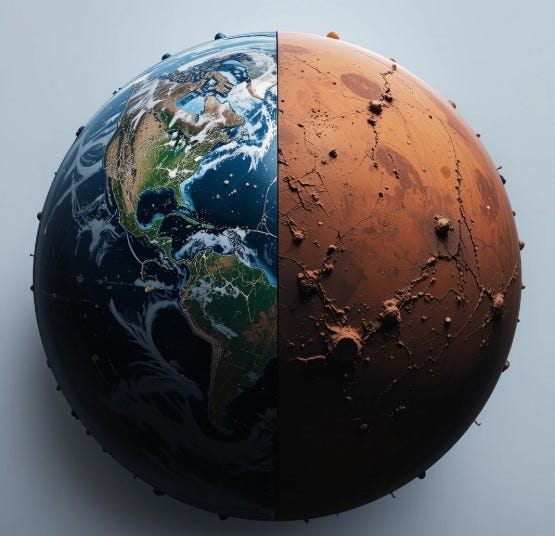The red sands of Mars whispered with wind and memory. It had been two Earth years since the Zeyari’s attempted occupation was halted, and in that time, Henry Hepponstall, the young astrophysicist from Cairns, had become more than a hero. To Earth, he was a savior. To Mars, a bridge. And to Meymoona, the Martian scholar who once saved his mind from indoctrination, he was home.
Henry had chosen not to return to Earth. The planet he’d long gazed upon through telescopes felt distant, fragmented, and worn. Instead, he stayed behind with Meymoona on the Martian moonbase, now transformed into a place of diplomacy and dreaming.
In the days after the war, Earth’s leaders had celebrated unity in rhetoric, but mistrust simmered beneath the surface. The old divisions, nationalism, competition, economic disparity, still festered. The peace, Henry feared, was fragile.
He knew the only way forward was not just healing, but transformation.
So he proposed what many considered madness: a complete reimagining of humanity.
He called it Project EarthOne.
In a transmission that reached every capital, every village, every device across Earth, Henry spoke with conviction that rang beyond science:
“We have stared extinction in the face, not from a comet or an asteroid, but from the consequences of our own inability to unite. Had we been more divided, we would have lost everything.
Let us not return to that dangerous comfort of borders and flags. Let us evolve, not just technologically, but morally, ethically, collectively.
I propose we dismantle the concept of nations.
Let there be no more Australians or Americans, Chinese or Congolese. Let us be Earthlings.
And let Mars and Earth collaborate as twin civilizations, helping each other survive, thrive, and reach out to the stars, not as conquerors, but as caretakers.” “Putnam’s thoughts coming to life”
What followed was chaos.
Governments balked. Power brokers resisted. The people were confused. Protests erupted, media spun myths, conspiracy theories bloomed like algae in fear. There were weeks when Henry wondered if he had gone too far.
Yet he persisted. Alongside Meymoona, he initiated The Red Summit, a months-long series of mediated dialogues between global leaders, cultural elders, spiritual figures, scientists, and even children. He didn’t demand they agree, only that they imagine.
And they did.
Meymoona became the quiet heart of the process. Her voice, resonating with otherworldly calm, reminded the Earthlings what their neighbors had almost done, and why.
“We Zeyari became predators out of hunger and desperation. Do not let yourselves fall into that trap. Cooperation is not surrender. It is survival.”
Slowly, the tides began to turn.
It started with small nations, those long silenced in world politics. They were the first to sign Henry’s EarthOne Charter, seeing in it not the loss of sovereignty, but the gain of voice.
Then came youth movements, sweeping across continents like wildfire. Students refused to pledge allegiance to flags. Artists painted murals of an Earth without borders. Musicians sang in multiple languages with one chorus: "We are The World."
Eventually, the great powers could not ignore the groundswell. Debates in the UN turned from defensive to visionary. Treaties were rewritten. Militaries were disbanded, slowly. Economies were restructured around collaboration instead of competition.
After two more years of arduous, impassioned transition, it happened.
On March 21, 2041, Earth’s leaders stood together in Geneva, where the last borders were ceremonially erased, and signed The EarthOne Accord. From that day forward, humanity ceased to exist as a collection of competing nations and became a unified planetary entity, governed by the Earth Council, a rotating body of representatives chosen not by geography, but by wisdom, innovation, and empathy.
With EarthOne established, attention turned outward.
Mars and Earth, no longer rivals, now worked as twin nodes of an emerging interplanetary civilization. Zeyari engineers and Earth scientists collaborated on energy systems that harvested quantum fields from solar winds. Martian terraforming began, slow, patient, and cooperative.
Education was revolutionized: children on both planets learned not only about the science of the stars, but the history of division and the cost of ego. They studied diplomacy like they once studied war.
A joint Mars-Earth orbital station, Unity Halo, was built, a glittering ring of peace in low space, symbolizing the collective will to never return to the ways of old.
And Henry?
He became the quiet architect of the future, not a president or ruler, but a guide. He and Meymoona lived modestly in a Martian settlement known as Horizon Nest, where the first Earth-Zeyari children played under two moons and wrote poems in languages not yet named.
He often spoke at the EarthOne Assembly, always reminding them:
“Unity is not sameness. We are many minds, many cultures, many dreams, but one home. One Earth. One Mars. One chance.”
In time, Project EarthOne expanded beyond the solar system. Plans were drawn for the first generational ships to Proxima Centauri. Earthlings and Martians would travel together, not as conquerors, but as gardeners of life.
They carried no flags. Only seeds.
And in the silence of space, humanity was reborn, not as a species that feared the other, but as a family that remembered what almost was lost.
And what was finally found.




